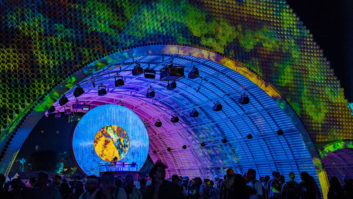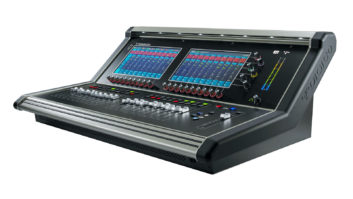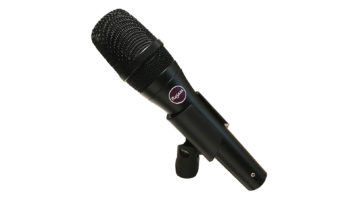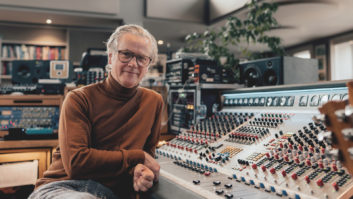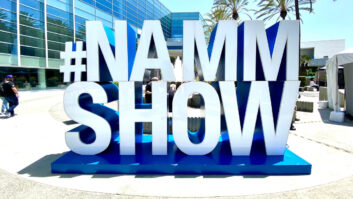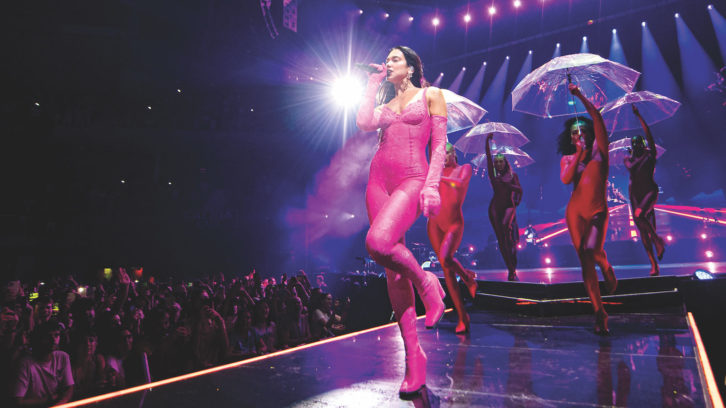
New York, NY (July 18, 2022)—By all rights, Dua Lipa’s second album should have bombed. Released in March 2020, a record about going out, partying and having socially un-distanced fun couldn’t have been more out of step with the times during the frightening early days of the pandemic. Instead, Future Nostalgia became a worldwide smash—and a totem that lived up to its name, helping young fans get through lockdown by tapping into memories of good times past and the promise of more yet to come.
Two years, six singles and a Grammy for Best Pop Vocal Album later, the record is finally getting its long-delayed tour—perhaps now a victory lap—as Lipa spends 2022 circling the globe through November for what will ultimately be 81 shows.
Along for the ride is her longtime FOH engineer, Will Nicholson, helping to bring the party to the people. “The artist’s creative approach to the show, very broadly, is the experience of going on a night out, meeting people, partying and hanging out, so we want it to be true to the record whilst giving it that live feel,” he said. “It is important that the songs sound like the record that people have spent time listening to at home, particularly the last two years during the pandemic. I think they’re quite attached to the sound of that record, so to depart from that would not be overly welcome.”
While there’s plenty of spectacle on display— the tour requires 20 trucks for its extensive production gear—the heart of the show is still the music, delivered by Lipa and a four-piece band (keys, guitar, bass, drums), plus four background vocalists. All that results in 60 mixable inputs coming to FOH, which Nicholson handles on a DiGiCo Quantum 7 console. “The DiGiCo is a very clean-sounding board; what you put in, you get out of it, as it doesn’t color anything without being told,” he noted. “There’s a few cool tricks in there that have allowed me to get rid of a lot of plug-ins—which has been very welcome, to be honest. Being able to trim that down and make the touring package a bit lighter on its feet was really useful.”
That said, a UAD-2 Live Rack still resides at the mix position, serving up Sonnox plug-ins plus emulations of classic outboard gear like Empirical Labs Distressors, dbx 160s and more: “I have Shadow Hills on my master bus with some EQ—not a lot on the individual channel inserts; I tend to use it on buses, primarily. Also, I prefer to mix into compression rather than going out to individual inserts or individual chains. Alongside some select outboard, this allows me to present my mix as the artist intends.”
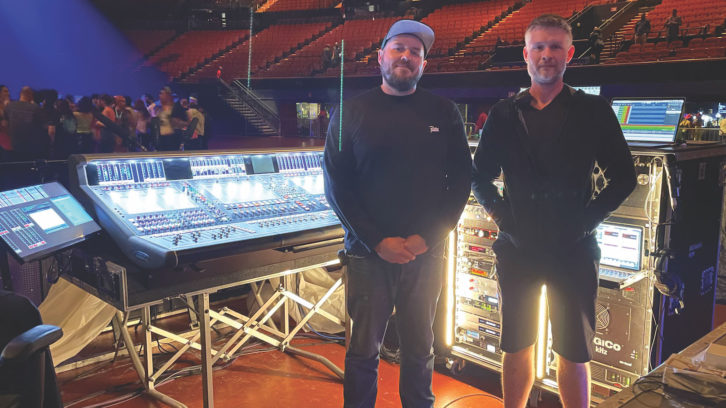
Thanks to those tools, Nicholson’s mix keeps the fans on their feet, but there’s one fader that matters more than all the rest, and that, of course, is the vocal. Capturing Lipa onstage nightly is a Shure Axient Digital wireless system outfitted with Shure’s brand-new, flagship KSM11 cardioid condenser capsule. While it was launched in April this year, Nicholson’s quite familiar with the capsule, having been directly involved in the KSM11’s development over the last few years, using multiple pre-release iterations and now the standard production model on the current tour. To entrust a rising artist’s vocal to a beta-test capsule was no small leap of faith, but it was one that paid off for multiple reasons.
“Honesty is the biggest thing,” said Nicholson. “I don’t want to make somebody’s voice sound different; I want it to sound like their voice singing or speaking, and the 11 did that from the beginning. It has a lovely high end, which is really important because there’s so much air and lift in modern pop vocals, and reproducing that live is challenging. The 11 does it subtly; it doesn’t force the issue, so it responds to EQ really well, you can tailor it to what you need and it’s very good with proximity.”
The KSM11 helped not only the vocal but the tour in general as the show was being developed. “We needed a microphone that we could throw things at,” Nicholson explained. “If production wanted to do something—say, for example, to fly the artist in front of the P.A.—we knew that we could try that without any trepidation. The 11 responded well to being in front of speakers because the rejection is excellent; the pickup pattern is very tight, so when she comes off the mark, it’s not getting flooded with spill. That’s allowed us to roll with everything; when people have asked for things—a choreographer wants to make something happen—we’ve been able to say, ‘Yeah, no problem.’”
Lipa does in fact wind up in front of the P.A. nightly, appropriately taking to the air for the hit “Levitating,” as she travels above the crowd in a basket. Even on the ground, though, she spends a good portion of the show in front of the P.A. on a thrust and a B-stage deep in the audience. As is usually the case for pop tours, the staging is kept clean, eschewing wedges as the performers hear the show via JH Audio IEMs on Shure PSM1000 wireless packs. All those mixes are tackled by engineer Alex Cerutti, working in Monitorworld beneath the deck on another DiGiCo Quantum 7 desk.
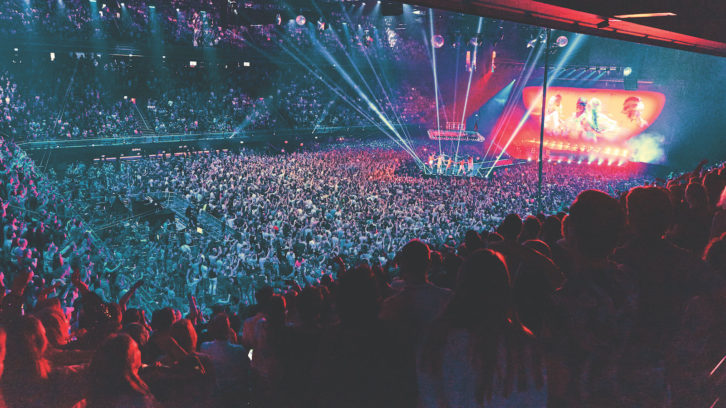
Cerutti may be hidden from view, but the musicians are definitely part of the show. “There’s no miming; if you can see it being played, you’re hearing it,” says Nicholson. “There’s plenty of live instrumentation—a full drum kit that also has triggers, guitar and bass, the keyboard player playing control surfaces live—so the approach has been to play the songs.” The guitar and bass play through Kemper Profilers to avoid having cabinets on stage. The drum kit, meanwhile, is captured via a variety of mics, as both a Sennheiser e 901 and an Audix D6 are used on the kick drum, and the two snare drums each get the identical miking of a Beyer M 201 TG and a Shure KSM32. Neumann KM 184s are used on the hi-hat and ride cymbals, and the overheads are Mojave Audio MA-201fetVG condensers. Backing vocals are grabbed by Telefunken M80 capsules on Axient Digital handhelds, and anything else on stage comes into the system via Radial DIs.
Hanging above all that is a sizable L-Acoustics line array system with main and side hangs of K1s and K2s, rear hangs of K3s and two-dozen subs in the air; back on the ground, as many as 24 subs are used on the floor, depending on the venue size. The entire audio system is provided by UK-based Britannia Row, and by extension, its parent company, Clair Global. “Clair have made an effort to treat [all their divisions] as one global family,” said Nicholson, “so we have one project handler, I write one spec, and then they deal with it internally as much as possible—which has been pretty seamless, to be honest.”
While the summer months are being used to play a few festivals and knock out some stray make-up gigs, this Fall will see the tour hit Latin America and then move on to wrap up in Australia. No matter where it goes, however, the mission will be the same: to let fans cut loose and create some future nostalgia of their own.
“I think when you’ve got pop shows, you get people who are attending their first or second or fifth show, and they’re with their friends or maybe family,” said Nicholson. “It’s important that the show itself is just enjoyable and fun, that it’s everything that they’ve hoped for. They can just let the hair down and dance, and there isn’t another agenda to it. I put myself in the shoes of somebody who’s, say, 15 and going to a show with their mates, and they just want to dance—they don’t want to be thinking about the kick drum!”
